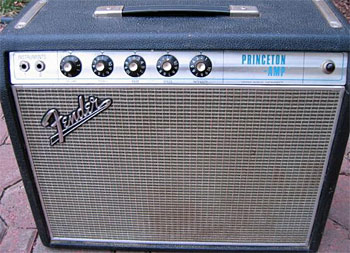Fender Princeton: Small Package, Big Wood
 Recently saw a short blog post on GuitarPlayer.com called “Desert Island Amp,” by guitarist guitarist and studio whiz Carl Verheyen.
Recently saw a short blog post on GuitarPlayer.com called “Desert Island Amp,” by guitarist guitarist and studio whiz Carl Verheyen.
I read it, checked out a couple YouTube vids (I know, not great for tone, but not going by them alone), and am sold: I’m looking for an old Fender Princeton, which can be had at reasonable cost – maybe even below reasonable on Craigslist.
Step A
Here’s most of the post:
I’m a Fender Princeton fan. I have three of them and they seem to be ON all the time.
Two 1964 blackface Princetons live in my studio, built into the cabinet/counter top/work station where I write, practice, arrange, jam with fellow guitarists and occasionally teach.
The third one, a Silverface ’67, lives in the garage as a go-to amp for smaller sessions that require an overdub or two. It fits in the trunk and always delivers the goods.
On important record dates (especially on my own records) I’ve mic’d a stereo pair for a truly gorgeous clean tone. With the volume on 3 or 4, these amps have a tone that blooms in a way that only a pair of 6V6 tubes can do.
But I rely on the Princetons for another important reason: tweaking. I consider this model amp to be “ground zero” for electric guitar. The way electric guitar was intended to sound, as per Leo and possibly God. I can sit directly in front of one and really hear what the guitar is doing.
A Princeton is a reliable window to the rest of my amp collection, too: If I get pickup heights, tone controls or the action on my guitars sounding good through a Princeton at home, I can be assured it will sound good through the big amps on stage.
Step B
This is all you need to hear:
More
That video reminded me of last year’s Amp Show, I think it was, in the Lollar Pickups room. Sounded F-ing great. Totally forgot about it.
I’m officially on the lookout, maybe you should be too. Vintage Princeton owners – give us the skinny on your amps below.














I would recommend a Satellite White or a Shanghai 64/1. The Shanghai is based on a 1964 Princeton Reverb and has been modified with another reverb spring making a BIG difference in just how crazy it can get, and is made in a small guitar store in Oklahoma, completely in house. You choose speakers, tolex, grill cloth and knobs. I have a surf green 64/1 head with silver grill cloth and cream chicken heads on a matching 2X12 with Celestions and it sounds impressive. I doubt you could feel better about making a purchase based on the fact you’re getting an amp with the exact look you want, handwired and built from the ground up in the States.
Satellite has been known for some of the best amps in the world and their few-knob mentality makes for easy adjustments and Adam Grimm is among the nicest amp builders I’ve ever met. If you were to tell me that all of the world’s amps disappeared except for Adam’s, I’d be OK with that. His stuff is awesome.
Have a ’68 which was blueprinted/optimized by George Alessandro with a Jensen C12N which blows people away when they hear it. My #1!(aside from his own builds)
I ran into a 60’s Vox Cambridge Reverb that is this amp for me.
It is a rarer tube one, and has replaced 90% of the stuff I used to drag to jams. It stands up and barks at half stacks, and with a reconed gold Bulldog 10″, the open back fills any room – front and back.
Reverb is pretty, but the tremo is limp, but with any old guitar it is a fun ride at any volume! Add a pedal in front to take it further.
Buy em if you find em!
allow me to give a plug for my friend Mike Marsh and his company, Marshamps.com.
You can get a princeton reverb from his site: kit or built. Fresh, new hi quality innards. If you choose to build you will gain insights into amp tweaking.
If I survive the latest sweep of layoffs at my company, I hope to get a bandmaster (the same kind EVH likes).
I’d also like to get a Princeton one day. A little tip about vintage Fenders (in case you don’t know), if you can find an early silverface that was built in late ’67 or early-mid ’68 then they will often times be the exact same amps as the blackfaces. Different faceplate and grill cloth but the exact same innards. They typically have white tubing around the outside of the grill cloth as well and sometimes vertical black lines on the faceplate. But it’s always best to check transformer numbers and make sure the amp has the blue molded mallory caps. I got my Silverface ’68 Twin Reverb for next to nothing even though it has the same innards as the BF Twins. You can save a lot of money this way.
My two favorite amps, period; are a ’65 Princeton Reverb Reissue that I swapped out transformers to make it more in line with the tone of the older ones, and a Princeton Reverb Recording amp. The recording amp sounnds just like the regular one, with a built in attentuator, along with compression/overdrive controls. Not a Princeton in the purist sense, but a great sounding and highly controllable.